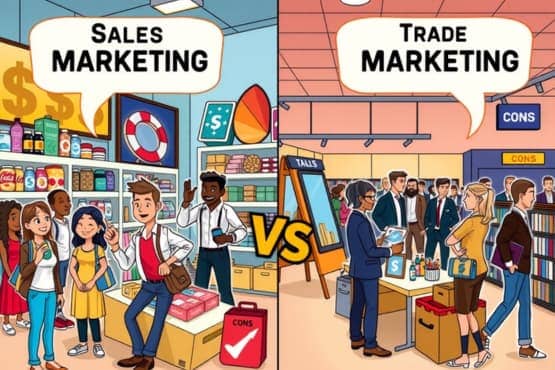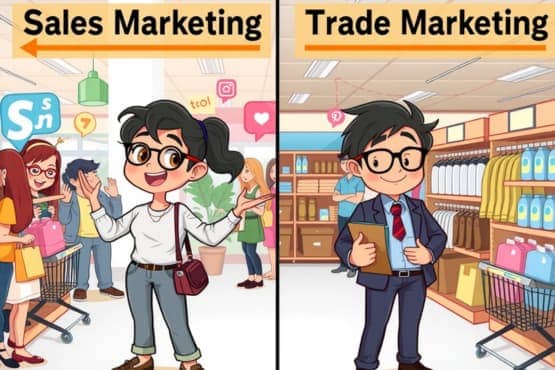Are you puzzled about when to use sales marketing vs trade marketing? Understanding these two approaches is crucial for boosting your market presence and profitability.
Let’s dive into the key differences between sales marketing and trade marketing, exploring their unique goals, target audiences, and methods to help you make smarter decisions for your business.
Understanding Sales and Trade Marketing
Even marketing pros sometimes scratch their heads over the differences between sales and trade marketing. But here’s the thing: mastering these distinctions is crucial for creating marketing strategies that move the needle.
Sales marketing is about wooing end consumers to buy your products or services. Trade marketing, on the other hand, focuses on the middlemen – your retailers and wholesalers.
The lines between these approaches can get a bit blurry. However, understanding their core differences is still important for businesses looking to supercharge their marketing and achieve long-term success.
Definitions: Sales Marketing vs Trade Marketing
Sales Marketing
Sales marketing is about strategies and tactics aimed directly at potential customers. It’s all about creating buzz, building your brand, and nurturing customer relationships to boost sales and revenue.

Trade Marketing
Trade marketing, in contrast, is about marketing your products or services to your partners in the distribution chain – think retailers, wholesalers, and distributors.
The goal? To ramp up demand, ensure your products are front and centre when customers are ready to buy.
| Aspect | Sales Marketing | Trade Marketing |
|---|---|---|
| Primary Focus | End consumers | Retailers and distributors |
| Main Objective | Drive direct sales | Enhance channel relationships |
| Key Activities | Advertising, promotions, direct marketing | In-store promotions, trade shows, channel incentives |
Main Objectives
Sales Marketing Objectives
- Boost direct sales to consumers
- Build brand awareness and loyalty
- Grow the customer base
- Maximize customer lifetime value
Stat: According to a recent Gartner report, companies that align their sales marketing objectives with customer needs see a 20% jump in customer satisfaction scores and a 15% boost in revenue growth. Not too shabby, right?

Trade Marketing Objectives
- Strengthen relationships with channel partners
- Increase product visibility in retail environments
- Streamline the supply chain
- Help retailers sell products more effectively
And get this: A McKinsey study found that businesses with strong trade marketing strategies achieve up to 5% higher market share growth than their competitors. That’s the power of trade marketing in action!
Who Are You Targeting?
Sales Marketing Target Audience
Sales marketing is all about reaching the end consumers – the folks who’ll use your product or service. This audience can be super diverse, so marketers often segment them based on demographics, psychographics, and behaviour.
For example, think about Warby Parker, the trendy eyewear brand. They focus their sales marketing efforts on millennials and Gen Z consumers who love online shopping for glasses.

Trade Marketing Target Audience
Trade marketing, on the other hand, targets the middlemen:
- Retailers
- Wholesalers
- Distributors
- Sales representatives
These guys play a crucial role in getting your products to end consumers. Trade marketing aims to influence buying decisions and motivate them to push your product.
Take Procter & Gamble, for instance. They invest heavily in trade marketing to secure prime shelf space and promotional support from big retailers like Walmart and Target.
Effective Marketing Strategies
Effective Sales Marketing Strategies
- Personalized email campaigns
- Social media marketing
- Content marketing
- Search engine optimization (SEO)
- Pay-per-click (PPC) advertising
Real-world example: Remember that Danish online bookstore we mentioned earlier? They used targeted emails based on user behaviour and saw their open rates skyrocket by 290% and conversions jump by 80%. That’s the power of personalization in sales marketing!

Effective Trade Marketing Strategies
- Trade shows and exhibitions
- In-store promotions and displays
- Co-op advertising
- Channel partner training programs
- Supply chain optimization
Another excellent example of trade marketing in action is Coca-Cola’s “Share a Coke” campaign. Personalizing bottle labels and creating eye-catching in-store displays boosted product visibility and engagement at the point of sale.
The result? A 2.5% increase in total sales volume. Not bad for a company that was already dominating the market!
Tools and Techniques:
Sales Marketing Tools
- Customer Relationship Management (CRM) systems
- Email marketing platforms
- Social media management tools
- Analytics and reporting software
- Marketing automation platforms
Did you know that companies using CRM systems see an average increase of 29% in sales revenue? That’s according to a report by Salesforce. Pretty impressive, right?

Trade Marketing Tools
- Trade promotion management software
- Point-of-sale (POS) systems
- Inventory management tools
- Channel partner portals
- Market research and analytics platforms
And here’s another interesting tidbit: A study by Forrester Research found that companies using trade promotion management software cut their promotional spending waste by 10-15%. That’s a significant saving in anyone’s book!
Pros and Cons:

| Aspect | Sales Marketing | Trade Marketing |
|---|---|---|
| Pros |
|
|
| Cons |
|
|
When to Use Each Strategy
Knowing when to use sales marketing vs trade marketing can make or break your marketing efforts. Let’s look at some real-world scenarios:
When to Use Sales Marketing
- You’re launching a fantastic new product directly to consumers
- You’re breaking into a new market or geographic region
- You want to grab more market share and fast
- You’re selling products with a short sales cycle
For instance, imagine you’re running a small e-commerce brand selling handmade jewellery.
You’d probably focus on sales marketing through Instagram ads and influencer partnerships to reach your target audience directly.

When to Use Trade Marketing
- You’re introducing products that need retailer support
- You’re expanding your distribution channels
- You’re fighting for shelf space in retail stores
- You’re selling products with a longer sales cycle or higher price point
You’re a large FMCG company launching a new line of fancy skincare products.
You’d likely invest heavily in trade marketing to secure prime shelf space and promotional support from major beauty retailers.
Integration of Strategies
While sales and trade marketing have their playgrounds, combining these strategies can create severe marketing magic.
A holistic approach considering end consumers and channel partners can create a robust and effective marketing strategy.

Here are some key ways to integrate sales and trade marketing:
- Make sure your brand messaging is consistent across all channels
- Share those juicy consumer insights with your trade partners
- Coordinate your promotional activities for maximum impact
- Develop omnichannel strategies that benefit both consumers and retailers
Want to see integration in action? Check out Unilever’s “Path to Purchase” strategy. They successfully blended sales and trade marketing by creating a seamless experience from online discovery to in-store purchase.
The result? A whopping 50% increase in marketing ROI. Now, that’s what we call a win-win!
Emerging Trends:
Sales Marketing Trends
- Personalization is king, and AI is making it easier than ever
- Voice search and conversational marketing are on the rise
- Influencer marketing and user-generated content are still hot
- Customer experience and journey mapping are more critical than ever

Trade Marketing Trends
- Augmented reality (AR) is making waves in in-store experiences
- Big data is enabling super-targeted trade promotions
- Digital trade marketing platforms are becoming the norm
- Sustainability and ethical sourcing are increasingly important
Here’s a fun fact: A recent Deloitte report shows that 75% of CPG companies plan to pump more money into digital trade marketing tools over the next three years. The digital revolution isn’t just for sales marketing anymore!
Common Misconceptions:
Let’s bust some myths about sales marketing vs trade marketing:
| Common Misconceptions | Truth |
|---|---|
| Trade marketing is the less important cousin of sales marketing. | Both play crucial roles in a killer marketing strategy. |
| Sales marketing always gives you quicker results. | Trade marketing can lead to more stable, long-term growth. |
| Trade marketing is just about promotions and discounts. | It’s about optimizing the entire distribution channel. |
| Sales and trade marketing are entirely separate beasts. | Integrating both approaches often leads to the best results. |
Conclusion:
Understanding the ins and outs of sales marketing vs trade marketing is key to developing a killer marketing strategy. While sales marketing is about directly wooing end consumers, trade marketing focuses on building strong relationships with your channel partners and ensuring your products shine at the point of sale.
Both approaches have their strengths and are better suited to different scenarios. The secret sauce? Knowing when and how to use each strategy and blend them effectively.
As markets keep evolving, especially with the rise of digital channels and data-driven decision-making, navigating sales and trade marketing will become even more valuable for businesses across all industries.
By tapping into the unique benefits of both sales and trade marketing, companies can create a robust, multi-faceted approach that covers all bases of the marketing and distribution process.
This holistic strategy drives direct sales and ensures strong relationships with trade partners, ultimately leading to sustained business growth and market success.




